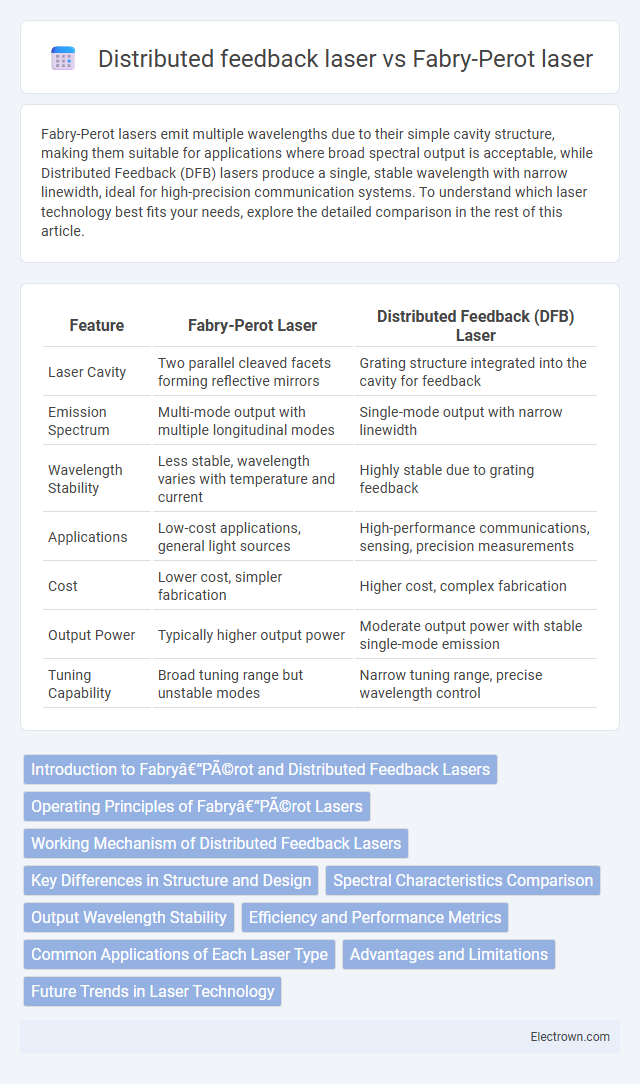Fabry-Perot lasers emit multiple wavelengths due to their simple cavity structure, making them suitable for applications where broad spectral output is acceptable, while Distributed Feedback (DFB) lasers produce a single, stable wavelength with narrow linewidth, ideal for high-precision communication systems. To understand which laser technology best fits your needs, explore the detailed comparison in the rest of this article.
Table of Comparison
| Feature | Fabry-Perot Laser | Distributed Feedback (DFB) Laser |
|---|---|---|
| Laser Cavity | Two parallel cleaved facets forming reflective mirrors | Grating structure integrated into the cavity for feedback |
| Emission Spectrum | Multi-mode output with multiple longitudinal modes | Single-mode output with narrow linewidth |
| Wavelength Stability | Less stable, wavelength varies with temperature and current | Highly stable due to grating feedback |
| Applications | Low-cost applications, general light sources | High-performance communications, sensing, precision measurements |
| Cost | Lower cost, simpler fabrication | Higher cost, complex fabrication |
| Output Power | Typically higher output power | Moderate output power with stable single-mode emission |
| Tuning Capability | Broad tuning range but unstable modes | Narrow tuning range, precise wavelength control |
Introduction to Fabry–Pérot and Distributed Feedback Lasers
Fabry-Perot lasers utilize a simple resonant cavity created by two parallel mirrors, producing multiple longitudinal modes and a broader spectral output. Distributed Feedback (DFB) lasers incorporate a periodic grating structure within the gain medium to provide wavelength-selective feedback, enabling single-mode operation with narrow linewidth and stable emission. Your choice between Fabry-Perot and DFB lasers depends on the required spectral purity and application-specific performance criteria.
Operating Principles of Fabry–Pérot Lasers
Fabry-Perot lasers operate by reflecting light between two parallel mirrors forming a resonant cavity, which amplifies specific wavelengths through constructive interference. The laser emits multiple longitudinal modes due to the broadband gain medium and cavity structure, resulting in a broader spectral output compared to distributed feedback lasers. Your choice of Fabry-Perot lasers is often driven by applications requiring multi-mode operation and simpler fabrication.
Working Mechanism of Distributed Feedback Lasers
Distributed Feedback (DFB) lasers operate by incorporating a periodic grating structure within the semiconductor gain medium, which provides wavelength-selective feedback through Bragg scattering. This grating reflects a specific wavelength of light, enabling single-mode operation with high spectral purity and stability. Unlike Fabry-Perot lasers that rely on cleaved facets for feedback, DFB lasers achieve distributed optical feedback throughout the cavity, reducing mode competition and enhancing wavelength control.
Key Differences in Structure and Design
Fabry-Perot lasers feature cleaved facets acting as mirrors for optical feedback, creating a cavity with multiple longitudinal modes, whereas Distributed Feedback (DFB) lasers incorporate a built-in Bragg grating within the active region to provide wavelength-selective feedback, ensuring single-mode operation. The Fabry-Perot design relies on external mirrors for resonance, making its spectrum broader and less stable compared to the DFB laser's integrated grating that offers enhanced spectral purity and stability. Structurally, Fabry-Perot lasers are simpler and less expensive to fabricate, while DFB lasers require precise grating fabrication for optimized performance in applications like telecommunications.
Spectral Characteristics Comparison
Fabry-Perot lasers exhibit multiple longitudinal modes resulting in a broader spectral linewidth, typically ranging from several nanometers to tens of nanometers, whereas Distributed Feedback (DFB) lasers produce single-mode operation with a narrow linewidth often under 1 MHz due to their integrated grating structure. The spectral purity of DFB lasers makes them ideal for high-precision applications such as fiber-optic communication and spectroscopy, delivering stable wavelength output with minimal mode hopping. In contrast, Fabry-Perot lasers' multi-mode nature leads to less spectral coherence, limiting their use in applications requiring high spectral resolution.
Output Wavelength Stability
Fabry-Perot lasers exhibit broader output wavelength spectra with lower stability due to multiple longitudinal modes, causing wavelength drift under temperature variations and current changes. Distributed feedback (DFB) lasers provide high output wavelength stability through a built-in grating that enforces single-mode operation, crucial for applications requiring precise wavelength control such as coherent communications and sensing. Your choice between these lasers should prioritize DFB for consistent and narrow linewidth emission where wavelength accuracy is essential.
Efficiency and Performance Metrics
Fabry-Perot lasers exhibit broader spectral linewidth and higher threshold currents, resulting in lower efficiency compared to Distributed Feedback (DFB) lasers, which feature single-mode operation and narrower linewidths that enhance spectral purity and signal stability. DFB lasers provide superior performance metrics with lower relative intensity noise (RIN) and higher side-mode suppression ratio (SMSR), making them ideal for high-speed, long-distance optical communication. Your choice of laser source will impact overall system efficiency, with DFB lasers offering better modulation efficiency and lower power consumption in precise wavelength applications.
Common Applications of Each Laser Type
Fabry-Perot lasers are commonly used in short-reach optical communication and sensing applications due to their simple structure and cost-effectiveness. Distributed feedback (DFB) lasers, with their single-mode operation and narrow linewidth, are preferred in long-haul telecommunications, high-speed data transmission, and coherent optical systems. Your choice depends on factors such as required spectral purity, distance, and system complexity.
Advantages and Limitations
Fabry-Perot lasers offer simpler design and lower cost with broad wavelength emission, making them suitable for general applications but suffering from multimode output and lower spectral purity. Distributed feedback (DFB) lasers provide single-mode operation and narrow linewidth, enhancing performance in high-speed optical communication and sensing, yet they are more complex and expensive to manufacture. Your choice depends on the required spectral stability and budget constraints, with DFB lasers favored for precision and Fabry-Perot lasers for cost-effectiveness.
Future Trends in Laser Technology
Future trends in laser technology emphasize enhanced wavelength stability and spectral purity, with Distributed Feedback (DFB) lasers gaining prominence due to their precise single-mode output and integration capabilities. Fabry-Perot lasers are evolving through advanced cavity designs to improve efficiency and tuning range, but DFB lasers remain the preferred choice for applications requiring narrow linewidth and low noise. Your selection of laser technology will increasingly depend on specific requirements for coherence, integration, and spectral control in next-generation optical systems.
Fabry–Pérot laser vs Distributed feedback laser Infographic

 electrown.com
electrown.com